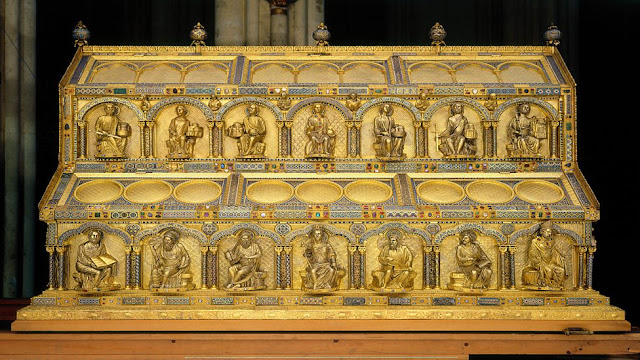Every year after we pass Halloween,
and in some stores even before then, we reach the biggest event for consumers
everywhere; Christmas. The marketing
seems to begin sooner every year, filling the stores, streets and homes with
trees, snowmen, tiny little lights, and cute nativity scenes. Prominent among these little sculptures and
Christmas cards are Middle Eastern men riding camels.
Much mythology has arisen around
these enigmatic characters through the years.
They are said to be three kings.
They are said to be representatives of the three sons of Noah; Shem,
Ham, and Japheth (that’s why one of them is pictured as an Ethiopian). They are said to be named Caspar, Balthazar,
and Melchior. And their three skulls,
amazingly enough, are said to have been found in the twelfth century by Bishop
Reinald of Cologne. The bishop personally
dug those up and knew right off they were the skulls of the three wise men of
legend. Their identity was
unquestionable, you see their eyes were still in the sockets and fixed toward
Bethlehem. Another tradition holds their
remains were first discovered by Saint Helena on her famous pilgrimage to
Palestine and the Holy Lands. She took the remains to the church of Hagia
Sophia in Constantinople; they were later moved to Milan (some sources say by
the city's bishop, Eustorgius I), before being sent to their current resting
place by the Holy Roman Emperor Frederick I in 1164. Today the putative remains of the three magi
are on exhibit in a priceless casket in a great cathedral in Cologne, Germany.
Silliness aside, there is a
fascinating history surrounding the mysterious visitors from the east
stretching back much further than Matthew chapter 2. The word Magi is often translated wise men or
magician, and is where we get our word for magic, but this is actually a
mistranslation of the word. In truth the
word cannot be translated as it actually is the name of a tribe of priests, who
began as an independent group and later became associated with the Zoroastrian
faith, from a people called the Medes. The Medes began as a tribal people in
Media located in modern day northwestern Iran. They were very skilled in
astronomy and astrology and had many religious practices that paralleled
Judaism. They were monotheistic. Their alter had a perpetual flame they believed to have been kindled by their god. They had a hereditary priesthood and discerned between clean and unclean animals. Perhaps these common elements allowed them to be more receptive to the worship of the promised Jewish messiah.


Comments
Post a Comment